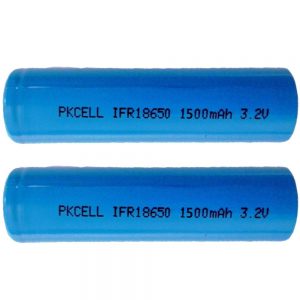Choosing the right battery type
Contents
Choosing the right battery type
Let’s take a look of our battery options:
4 x AA Alkaline – Waste of capacity due to its premature voltage decline during operation
5 x AA Alkaline – Input voltage of the regulator exceeded
1 x 3.7v Lipo – Voltage too low for regulator
2 x 3.7 Lipo – Voltage, well, come on. Don’t get picky.
The problem with the 3.7v Lipo is that its voltage starts at about 4.2 Volts when fully charged, and then gradually sinks to destruction when no protection circuit is in place. Two of them would start with 8.4 Volt and that is too much for our regulator. Are we being sucked into the black hole of power management?
Did you ever hear about LiFePO4 ? That’s gonna change now. LiFePO4 batteries are by far not as popular as Lipo/LiIon batteries, but they are the holy grale of ESP and Arduino battery operation. Why is that?

It starts with the average voltage of 3.2V. When fully charged, that will be 3.6v. If you now think that would still match (fingers crossed) the Vcc input of the Pro Mini, than you might be right … until the ESP-01 kicks in. A LiFePO4 battery will also be unable to maintain 3.2 volt when the ESP-01 starts operation, but it might be a good match for a Pro Mini standalone application. But that’s not what we have in mind. Connecting two LiFePO4 in series to the RAW input of the Pro Mini appears to be fine, but as I’ve explained before, the 3.3v output from the regulator cannot cope with the ESP-01 load. Our goal is to power both the ESP-01 and Pro Mini from the same battery pack and only one regulator, and that’s gonna happen now. We use the external power regulator from the previous chapter and connect two LiFePO4 batteries in series to its input (= 7.2v max). Then we connect the regulator’s 3.3V output to Vcc input of both ESP-01 and Pro Mini. After decoupling the ESP-01 with some capacitor, the show is about to begin. But not before I tell you about an important characteristic of LiFePO4 batteries. The voltage delta between fully chargerd and discharged is much flatter than that of Lipo batteries. In addition, over-discharging LiFePO4 batteries is by far not as dangerous as with Lipo. Lipos without proper protection circuit (either builtin or external) can be damaged if they are overcharged or even discharged below 2.6 Volts. If that happens, continue using them at your own risk. Better dispose of them properly.
LiFePO4 batteries are almost immune to such conditions. And their voltage delta between fully charged and discharged is much smaller (~ 0.6v) than that of Lipo (~ 1.2v). Keep in mind that you need a LiFePO4 compatible charger!